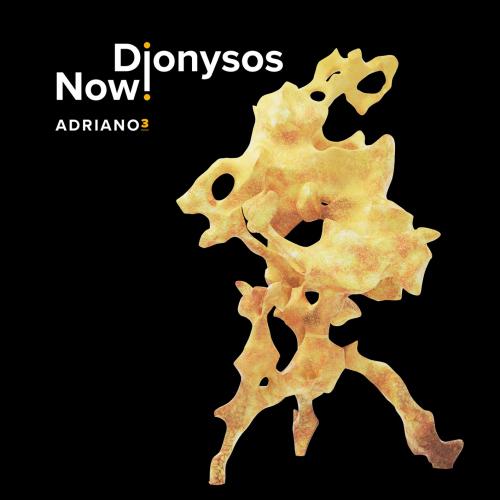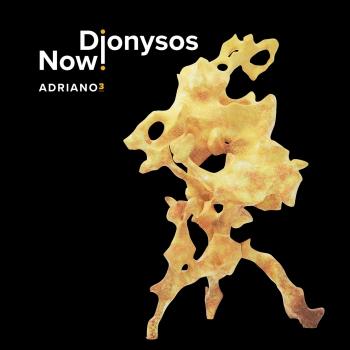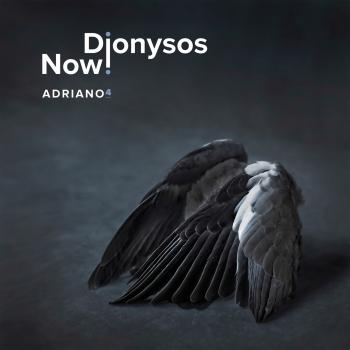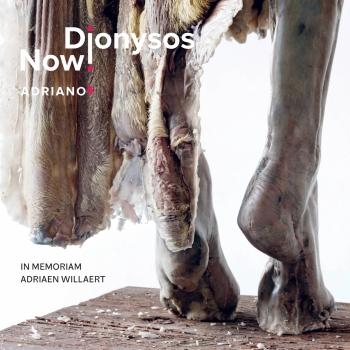
Adriano 3 Dionysos Now
Album Info
Album Veröffentlichung:
2022
HRA-Veröffentlichung:
02.09.2022
Label: Evil Penguin Classic
Genre: Classical
Subgenre: Choral
Interpret: Dionysos Now
Komponist: Adrian Willaert (1490-1562)
Das Album enthält Albumcover
- Adriaen Willaert (1490 - 1562): Missa Ippolito:
- 1 Willaert: Missa Ippolito: I. Kyrie 03:23
- 2 Willaert: Missa Ippolito: II. Gloria 04:47
- 3 Willaert: Missa Ippolito: III. Credo 07:15
- 4 Willaert: Missa Ippolito: IV. Sanctus 06:17
- 5 Willaert: Missa Ippolito: V. Agnus Dei 04:22
- Haud aliter pugnans:
- 6 Willaert: Haud aliter pugnans 02:42
- Victor, Io salve:
- 7 Willaert: Victor, Io salve 05:22
- Adriacos numero:
- 8 Willaert: Adriacos numero 05:01
- Si rore Aonio:
- 9 Willaert: Si rore Aonio 05:46
- Quando di rose d’oro:
- 10 Willaert: Quando di rose d’oro 02:28
- Qui boyt et ne reboyt:
- 11 Willaert: Qui boyt et ne reboyt 00:54
Info zu Adriano 3
Dionysos Now! continues their journey to immortalize the unexplored works of polyphonic master Adriaen Willaert. The third album in the series will be released on vinyl in September. The new album revolves around the Missa sine nomine. It is assumed that the work was composed between 1522 and 1527, at a time when Willaert was a member of the music chapel of Cardinal Ippolito d'Este in Ferrara, Italy. This rediscovered untitled Mass, which the ensemble have now sung as a world premiere, can therefore rightly bear the name Missa Ippolito.
Adriaen Willaert must have already been a prolific composer before he assumed the position of kapellmeister at the Basilica of San Marco in Venice. After all, a second Mass of his was included in a large, illuminated choral manuscript that was produced for the Illustrious Brotherhood of Our Blessed Lady in 's-Hertogenbosch, the Netherlands (the first Mass in this manuscript, Missa sex vocum super “Benedicta,” can be found on the LP Adriano 2).
The title page of the Mass does not mention the name of the composition, only that of the composer, Adrianus Willart. It was cataloged as a Missa sine nomine, a Mass without a name.
It is assumed that the work was composed between 1522 and 1527, at a time when Willaert was a member of the music chapel of Cardinal Ippolito d'Este in Ferrara, Italy. At first glance, what’s striking about this composition is that one of the tenor voices sings a cantus firmus (a “given, fixed, foundational voice” that provides the basis for each movement of the Mass, to which the other voices are added) that always consists of the same 13 notes: mi ut mi sol mi ut fa mi fa mi re mi.
In an article about the Mass, the musicologist Joshua Rifkin claims to have discovered a sogetto cavato delle parole in this sequence of notes. This is a compositional technique common for the time in which the notes of a melody, in this case the cantus firmus, are derived from the vowels of certain words. The notes used for the tone poetry are those of the Guidonian hexachord, a series of the 6 notes ut-re-mi-fa-sol-la. For example, the word Maria (Ma-ri-a) can be "translated" into the notes la mi la.
The cantus firmus of the Mass, according to Rifkin, fits the words “Primus Ippolitus Cardinalis Estensis” (Ippolito I, Cardinal d'Este) perfectly. The Mass is thus almost certainly (via a hidden message in the music) an ode to the Cardinal of Ferrara who was Willaert’s patron. This rediscovered untitled Mass by Adriaen Willaert, which we have now sung as a world premiere, can therefore rightly bear the name Missa Ippolito.
Dionysos Now!
Dionysos Now
I would like to show you that vocal polyphony of the Renaissance is very captivating music, and deserves to be heard by a wider audience.
Dionysos Now! wants to create cathedrals from sounds, in which you perceive the music as if you were flattering the cathedrals with a drone from far above. The brick stones are overall but they seem to merge into the whole, into the 'gestalt', where the radiant music generates much more effervescent energy than the sum of the tones, the contagious flow in the music is sought and captured, like a surfer who seems to have found the perfect wave and seizes his chance to float on it before it goes away again.
With the wise words of Winston Churchill in mind "Never waste a good crisis", I started studying the scores of my fellow townsman Adriaen Willaert during the lockdown and so I rediscovered the wonderful music of this Venetian chapel master over the past few months. A new initiative was born: Dionysos Now! Vienna is a brand new project that aims to spread the magnificent heritage of Adriaen Willaert. With Dionysos Now!, I would like to demonstrate that Renaissance vocal polyphony is very captivating music that deserves to be appreciated by a wider audience.
Tore Tom Denys, founder Dionysos Now! Vienna
Anyone who reads the name Dionysos Now! correctly will discover the reference to Denys: Tore Tom Denys is the founder and artistic director of the ensemble.
Dionysos Now! is also in Greek mythology the growth force of the earth and human civilisation, zeal and enthusiasm, god of wine (construction) and fruit growing, poetry, theatre and music. As god of peace he brings people together and as victor over death he is god of the underworld. In various ways he had an important influence on the life, thought and work of the Greeks and Romans.
An ideal figurehead, therefore, from a great recognition for Willaert's work, to want to share this oeuvre with a large audience in the most diverse forms with great enthusiasm. It is Tore Tom Denys' ambition to map out the work of his "fellow townsman" by means of concerts and original CD recordings and to give him the fame he deserves.
The ensemble works and rehearses from Vienna but has an international base and unites top soloists in polyphony. Tore Tom Denys has his own clear vision on how he wants to perform Willaert's oeuvre with care for the original manuscripts and scores.
Ensemble Dionysos Now! is a flexible project in which the basis consists of 6 voices which, depending on the programme, can be extended to polyphonic or supplemented with an instrumental ensemble. To this end, a permanent collaboration will be set up with various internationally renowned ensembles.
Tore Tom Denys
has worked and lived in Vienna for over 20 years but was born and raised in Roeselare.
Tenor Tore Tom Denys joined the vocal core of the Capilla Flamenca in 2006. He studied trumpet at the Conservatory of Antwerp and could be heard worldwide as a concert and solo trumpet player. From 1994 to 1998, as a member of the 'World Youth Choir', he visited all continents, where his interest in early music and the art of singing grew steadily and he changed the trumpet for singing. He was a member of the vocal ensemble Currende with whom he recorded several CD's and was co-founder of the Goeyvaerts Consort. etc...
In 1998 Tore Tom Denys moved to Vienna and studied singing at the "Konservatorium der Stadt Wien". He was admitted to the "Arnold Schönberg Chor" (conducted by Erwin Ortner) and went on various tours as a soloist with this choir. Since 1999 he has been a member of the choir of the Vienna State Opera and has performed with it at the "Salzburger Festspiele" in productions by L. Maazel, R. Muti, Gjergiev W. Sawallisch. Besides his performances at various festivals in Austria and abroad, he is a permanent soloist with the ensembles "Nova", "Armonico Tributo Austria", "Cinquecento" and "Clemencic Consort". He is also founder and singer of the ensemble "Vivante", an ensemble for early music, which mainly performs music from the Italian Early Baroque and Ensemble Dionysos Now!, with a focus on polyphony. He is also a much sought-after soloist by Philippe Herreweghe with Collegium Vocale Gent for the specific polyphony music.
Dieses Album enthält kein Booklet













